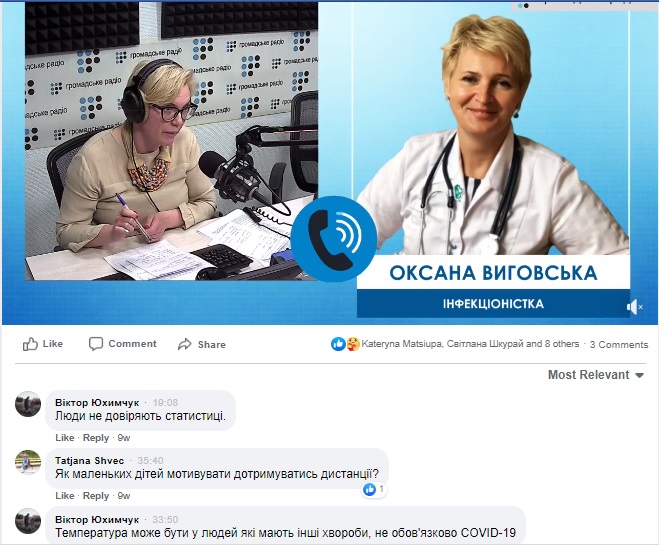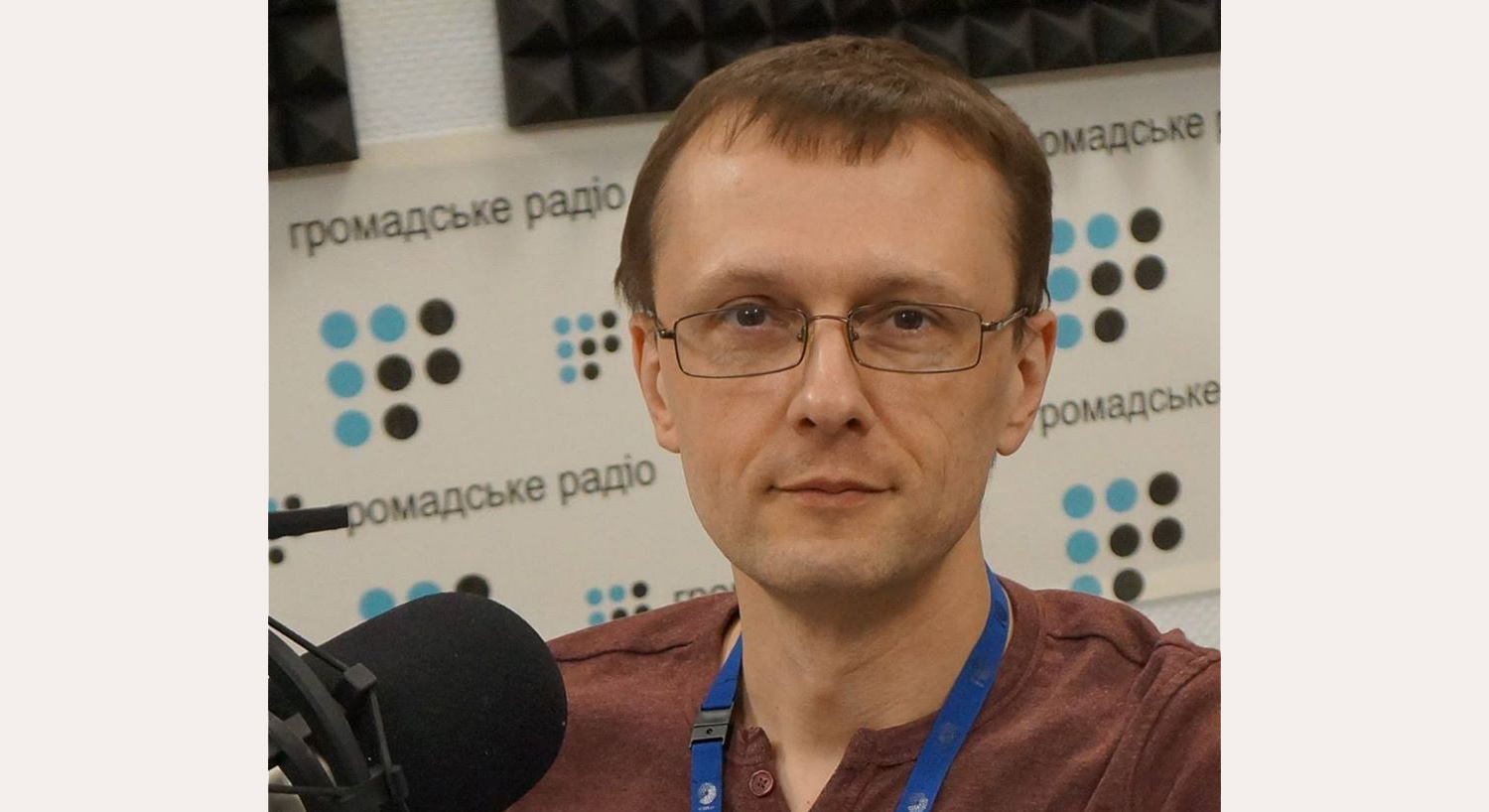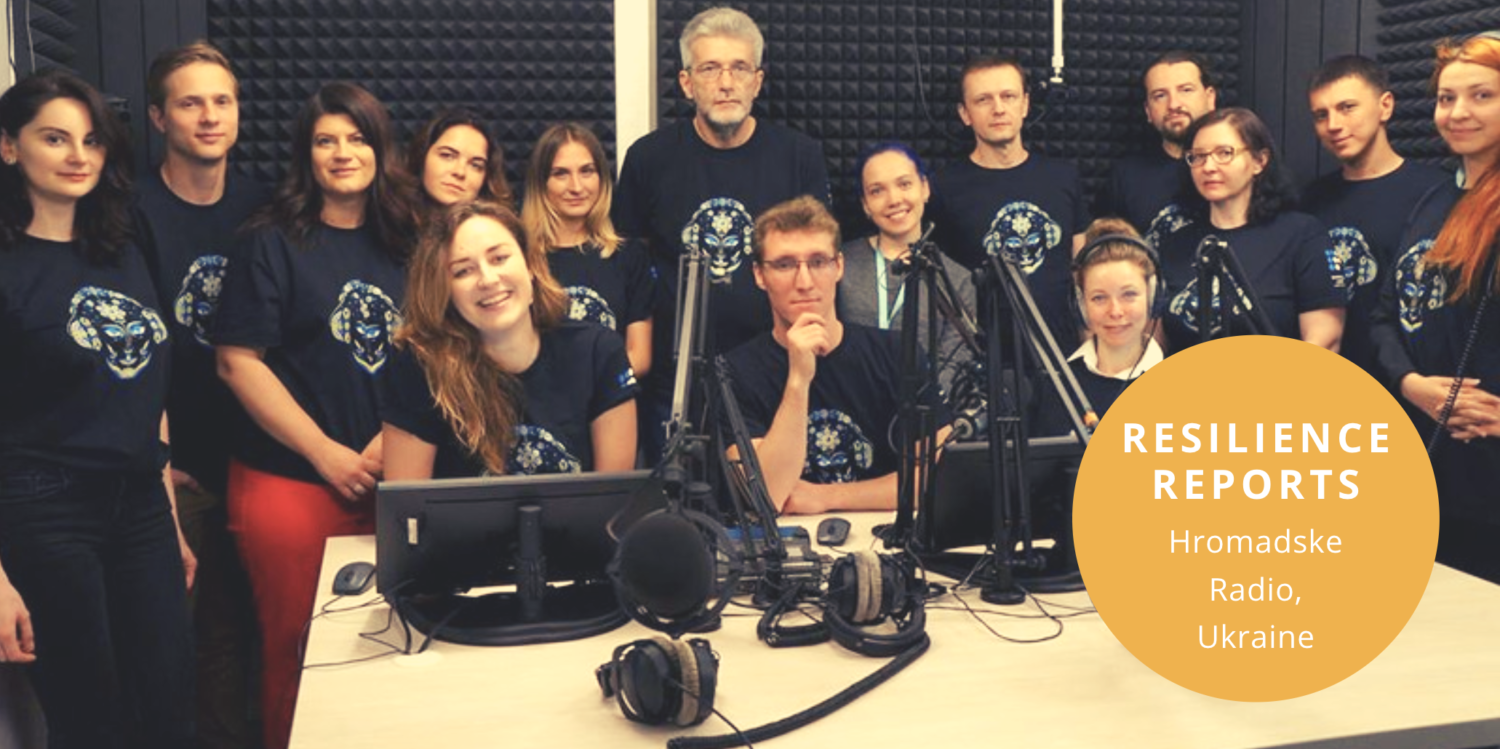This case study is part of Resilience Reports, a series from the European Journalism Centre about how news organizations across Europe are adjusting their daily operations and business strategies as a result of the COVID-19 crisis.
In a nutshell: Reliable COVID-19 news and human interest stories kept Ukrainian citizens in the capital and the east of the country up-to-speed during the pandemic
In March, Hromadske Radio — one of Ukraine’s few nonprofit radio stations — faced an issue: Citizens in the country didn’t care much about COVID-19.
Despite widespread coverage of the spread of the virus and serious restrictions put in place by the government, polling showed that citizens thought the coronavirus was just the fifth-biggest problem — after corruption, unemployment and other societal issues.
To help combat this perception, the 70-person station secured donors to create four new programs. Focusing specifically on its female audience, topics included domestic violence and child care as well as daily COVID-19 statistics and key public health messages. A regular schedule of podcast releases and new home setup for some of its talk show hosts helped bring in over 300,000 people to its website in April and thousands more to its FM frequency.
The European Journalism Centre’s Tara Kelly breaks down Hromadske’s approach to covering COVID-19 and what it learned from centering women over the last four months.
What is Hromadske Radio?
Established in 2013, Hromadske Radio is a public radio station based in Kyiv, Ukraine. It is one of Ukraine’s few non-commercial and non-governmental news talk radio stations and online media platforms and employs 70 full and part-time journalists and other staff.
Broadcasting 24 hours a day, seven days a week, the station reaches its listeners via satellite and its own broadcasting network, covering six regions across Ukraine. With 15 transmitters of its own, it has the potential to reach three to five million people in up to 25 cities and towns.
Transmitters are not easy to obtain as they must be licensed by the government and are restricted to certain frequencies and power levels. Many Ukrainian stations in the Donbas region are jammed by Russian channels, meaning listeners hear Russian-based broadcasts over the same frequency.
In addition to around 110,000 weekly listeners via FM radio, listeners can also access Hromadske online through its website and mobile app, both of which were redesigned last year.
As well as live programming, the website acts as a repository for more than 100 different Hromadske podcasts on everything from reasons to travel to Ukrainian music to how to verify information. Some are longstanding and have hundreds of episodes while others have a short run and have already come to an end. The podcasts are released via its website and via other podcasting platforms. Hromadske’s combined monthly web and podcast audience is around 200,000 to 300,000, depending on the month.
95% of Hromadske’s revenue comes from international donors, including the National Endowment for Democracy, International Renaissance Foundation, the United Kingdom’s Foreign and Commonwealth Office, and Pact. These donors are keen to financially support independent outlets like Hromadske Radio as their presence is deemed hugely important for protecting the interests of Ukrainian civilians in a media environment at risk from influence by oligarchs.
The other 5% of revenue is from listener donations and rental revenue from its recording studio. Hromadske has plans to gradually decrease the share of international donor money over time and to gain more listener donations to support its work.
Despite the introduction of a number of reforms since 2014 to increase transparency around media ownership, Ukraine is still ranked 96 out of 180 countries in the World Press Freedom Index by Reporters Without Borders.
Political tensions between Kyiv and Moscow over the annexing of Crimea by the Russian Federation in 2014 continues to have an effect on media coverage in the country. In 2017, a ban was imposed on Russian journalists and Russian-owned news outlets. A year later, any assets that Russian journalists had in the country were frozen as part of an extension of sanctions, according to the Committee to Protect Journalists. Since then, Ukrainian broadcast media can only air 30-40% of Russian content, despite the fact that much of the country is bilingual.
How did Hromadske Radio handle the COVID-19 crisis?
At the beginning of the pandemic in March, the editorial team included some COVID-19 related content in some of its existing broadcasts. However, it lacked funding for specially made programs focusing on the pandemic. It proved impossible to attract commercial funding for this, so the team applied for grants, which meant there was a delay launching the shows that it wanted.
In April, at the height of Ukraine’s pandemic, the team started producing a twice-weekly show called “Social Distance Talk Show.” Funded by two donors, the hourlong show covered the social and medical aspects of COVID-19 featuring experts including doctors, psychologists, health workers and teachers. For example, one show looked at the experience of a man who successfully recovered from COVID-19 while another looked at kids in lockdown and the time they were spending online.
In addition to airing on its FM station, a podcast version was released on its website, as well as SoundCloud, Spotify, Google Podcasts and Apple Podcasts. As the case numbers dropped in July, the team decided to scale back production to once a week.
Hromadske Radio launched two additional COVID-19 shows in May to inform listeners about different aspects of the pandemic. A daily rubric — COVID-19 News in the Morning — went out every weekday during the morning show with the relevant information about the coronavirus and key public health messages released by the Ukrainian government.
In the evening drive time slot, listeners could hear the daily COVID-19 radio news bulletin, including the latest government data on the number of positive cases in Ukraine and its death toll. The same bulletin was then published online as a news publication and a podcast on the website.
With women making up more than half of Hromadske Radio’s FM listeners and website audience, the team decided to create a podcast about women’s experience during COVID-19 that also aired on its FM station. “The Female Side of Quarantine” concentrated on personal stories of everyday women dealing with situations arising from the pandemic. For instance, one segment examined domestic violence during the lockdown, while another looked at how a mother of a 2-year-old girl coped during her quarantine experience.
Since April, Hromadske Radio has run a campaign urging its audience to verify information and be aware of COVID-19 stories that might not be true. Audio clips broadcast several times a day explain reputable sources of information and explain why it is important to listen to advice from the medical authorities. Other topics include why you should observe the two-meter social distancing rule and why it helps to wear a mask. These clips are also posted to social media. The aim is to help Ukrainians understand how the information they consume can help stop the virus’ spread.
Hromadske received plenty of feedback from its audience during this period, mainly via incoming calls received by sound engineers and guest administrators and funneled through to hosts and studio guests. There is also a significant number of comments that come through social media, particularly Facebook (45,000 followers to date), Twitter (41,700 followers) and Instagram (50,400 followers).
The interest in COVID-19 meant that, at the height of the pandemic, Hromadske’s website received 307,400 unique users and 491,700 pageviews in April.

(Courtesy: Hromadske Radio)
Hromadske Radio secured three new COVID-19-related grants during the first half of the year; one that the team applied for and two from organizations that contacted the station looking to support its work. These grants were especially important given the station was not able to generate its usual level of advertising revenue due to COVID-19-related economic downturn. Unlike other independent outlets in other countries, Hromadske didn’t see an uptick in donations from readers.
Face-to-face fundraising events, which count for 1% of Hromadske’s annual budget and take place up to four times a year alongside fundraising campaigns, have also had to be suspended due to the pandemic. These events usually support online crowdfunding campaigns — such as the campaign last year to buy an FM license from the government — and feature talks with the radio station’s most popular journalists as well as the editor-in-chief. Held in Kyiv, about 30 to 50 people typically attend such events. These will likely move online in the second half of 2020.
How has COVID-19 changed the future of Hromadske Radio?
The editorial team will concentrate more of its broadcasting on health care-related topics in the future. The Ukrainian public is increasingly interested in health because of the unsatisfactory level of health care in some regions and because the Ukrainian government is making efforts to reform the sector. Subsequently, and pending further funding, Hromadske is considering producing specific health-related shows. It will also invite more medical specialists onto its general interest shows to answer questions and talk about timely health issues.
Hromadske will continue to rely on more remote work for its operations due to the increasing number of confirmed cases in Ukraine over the last few weeks. Everyday activities will continue to be done online and meetings and conferences will use Zoom and Skype. Some reporters and presenters will continue to voice shows from home, though it depends on microphone and audio quality. Hromadske Radio will continue to use its studio for live shows and presenting the news.
In terms of revenue, Hromadske Radio plans to increase other income streams in order to become more sustainable and less dependent on grants. In April, following a successful round of crowdfunding, Hromadske launched a new commercially viable frequency in Kyiv. The new frequency is available on car FM receivers and will be monetized via advertising and sponsorship sales.
This will not be straightforward, given the fact that the pandemic has hit the advertising industry in Ukraine. For ethical reasons, Hromadske’s editorial board also made the decision not to run advertising from the alcohol or gambling industries, which are the main pillars of the Ukrainian radio advertising market. Many other Ukrainian media organizations find loopholes to this advertising ban and air those ads anyway.
What have they learned?

Kyrylo Loukerenko, the executive director and co-founder of Hromadske Radio (Courtesy)
“Hromadske Radio understood that the challenges are also opportunities. To our surprise, we learned how to do most of our pre-production meetings and some interviews remotely. ”
– Kyrylo Loukerenko is the executive director and co-founder of Hromadske Radio
This case study was produced with support from Evens Foundation. It was originally published by the European Journalism Centre on Medium and is published here under the Creative Commons Attribution-NonCommercial-ShareAlike 2.0 license. The Poynter Institute is also the fiscal sponsor of the Verification Handbook.






